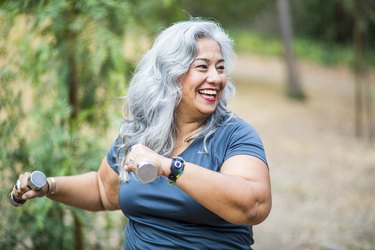
It's no secret that regular exercise is important. But when you have COPD, you might wonder whether your body is really up to the task.
Here's the good news: Not only is it possible to exercise with COPD (that's chronic obstructive pulmonary disease, for the record), but being active can actually have big benefits.
Video of the Day
Video of the Day
"The thought of working out might be overwhelming, but a well-designed exercise program may help those with COPD feel better physically and mentally and improve quality of life," says Carol Michaels, a certified exercise specialist and founder of Recovery Fitness.
The key is finding the right intensity without pushing yourself too hard. Here's what to know about COPD and exercise, including the best workouts to try and the ones you'll want to avoid.
How Exercise Can Help With COPD
Exercise can make you feel short of breath, so it's easy to wonder how it could possibly be good for COPD, which is marked by difficulty breathing. But experts agree that moderate physical activity is an integral part of protecting your health. "It's key for the overall management of COPD," explains SWORD Health physical therapist Merin Shekitka, PT, DPT.
Being active conditions your heart and lungs and increases your endurance, which can help your body use oxygen more efficiently and make breathing easier, according to the American Lung Association (ALA). In fact, moderate activity — starting with pulmonary rehabilitation — is one of the most effective non-drug treatments for COPD, according to 2013 findings in the European Respiratory Review.
While less shortness of breath might be the biggest benefit, it's far from the only one. Using oxygen more efficiently means you'll have more energy and endurance, making everyday activities easier. Exercise also improves your muscle strength and can keep body fat in check — two more biggies for protecting your health and feeling your best, per the Cleveland Clinic.
And the benefits are more than just physical. Whether you have COPD or not, exercise is a proven strategy for easing feelings of stress, anxiety and depression as well as sleeping better, according to the ALA. Which can add up to a better quality of life overall.
Are There Risks to Exercising With COPD?
Being active can go a long way toward managing your COPD and helping you feel better. But it's important to go about exercising safely. Pushing yourself too hard can make breathing difficult (though it won't damage your lungs), per the Cleveland Clinic.
Above all, you should get the green light from your doctor before starting an exercise program. Your provider can help you figure out how much activity is right for you, what types of workouts are best and the things you should avoid, plus whether you should take your medicine around your exercise schedule.
Even after getting your doctor's OK, it's worth starting with some expert guidance instead of striking out on your own. "The safest option is to take part in a supervised exercise program with a trained rehab specialist," Shekitka says.
That often takes the form of pulmonary rehabilitation or respiratory therapy. "These programs can help an individual gain the confidence to engage in exercise safely, and learn how to pace themselves when increasing their exercise time and duration," explains Esther Castilleja, a respiratory therapist with Texas Health. A respiratory therapist will also monitor your oxygen saturation levels while you exercise to figure out if you'd benefit from supplemental oxygen.
And whether you're just beginning or have been exercising with COPD for a while, listening to your body is always a must. Take a rest day if you have a fever or infection, and stop exercising if you feel nauseous, have unexplained leg or chest pain or are out of oxygen, the COPD Foundation recommends.
The 3 Best Types of Exercise for COPD

A combo of aerobic and strengthening exercises are best when you have COPD.
"Aerobic exercise improves cardiac function and oxygen capacity, while upper-body stretching and strengthening can help increase lung capacity," Michaels explains.
People with COPD should aim to be active for 20 to 30 minutes at a time, three or four times a week, per the Cleveland Clinic.
1. Walking
Walking is one of the easiest and most effective aerobic options out there. "It uses your whole body and helps improve overall conditioning and endurance level, which allows you to better tolerate other daily activities," Shekitka says.
Other low-intensity, low-impact exercises work too, like stationary bicycling or swimming, according to the ALA.
Ready to get started? Here's everything you need to know to start a walking program.
2. Upper-Body Strength Moves
Focus your stretching and strengthening efforts on your upper body in particular.
"Isolated strengthening exercises are great choices," says Shekitka. "Using a light weight or exercise band in a controlled manner is a good way to safely load the muscles without overexerting yourself."
Try These Workouts
3. Pulmonary Rehabilitation
For many people with COPD, pulmonary rehabilitation is a great place to start — especially if you're new to exercise. Think of it like physical therapy, but specifically for your lungs. Respiratory rehab is an especially good option if you feel like shortness of breath is limiting your activity, you use supplemental oxygen at home every day or you've recently stopped smoking, Castilleja notes.
Ask your doctor to help you find a pulmonary rehabilitation program near you.
No matter what activity you do, don't push yourself too hard. On a scale of 1 to 10 where 1 feels like you're breathing like normal and 10 feels completely out of breath, try to stick to an intensity that feels like a 3 or 4. "Never get over what feels like a 5 or 6," says Shekitka.
Finally, remember to warm up and cool down. A few minutes of stretching or walking at a slower pace will help your heart and lungs ease into a faster pace, and the same routine can help you recover from a workout without potentially feeling dizzy or lightheaded, according to the Cleveland Clinic.
Related Reading
3 Exercises to Avoid With COPD
Steer clear of any activities that could potentially raise your heart rate and oxygen level too high or strain your muscles. Remember, you want to aim to keep the intensity at a level that feels like a 3 or 4 to you, and never more intense than a 5 or 6. According to Shekitka, activities that tend to be off-limits include:
- High-intensity cardio like walking up steep hills, running or jogging, or high-impact interval training (HIIT)
- Lifting heavy objects or weights
- Isometric activities that involve pushing against a stationary object, such as push-ups or sit-ups
4 Tips for Breathing Easier During Exercise
Using some strategic breathing practices during a workout can help you take in more oxygen and ease feelings of slight breathlessness. You can try:
- Taking slow, deep belly breaths and exhaling through pursed lips
- For strengthening exercises, breathing in when you start the exercise and breathing out during the hardest part
- Exercising with supplemental oxygen, if you use it (your doctor or respiratory therapist can help you figure out the right flow rate for when you're active)
- Taking a break when you need it: If you feel like you're out of breath, stop exercising and sit in a chair that supports your shoulders until you feel like you can breathe normally
Lastly: Start slowly, increase your activity bit by bit — and know that everyone with COPD is different.
"There's no one-size-fits-all approach," Shekitka says. "Start at your own comfort level and gradually increase the intensity so you can do more work but still stay within your rate of perceived exertion."
Is this an emergency? If you are experiencing serious medical symptoms, please see the National Library of Medicine’s list of signs you need emergency medical attention or call 911.